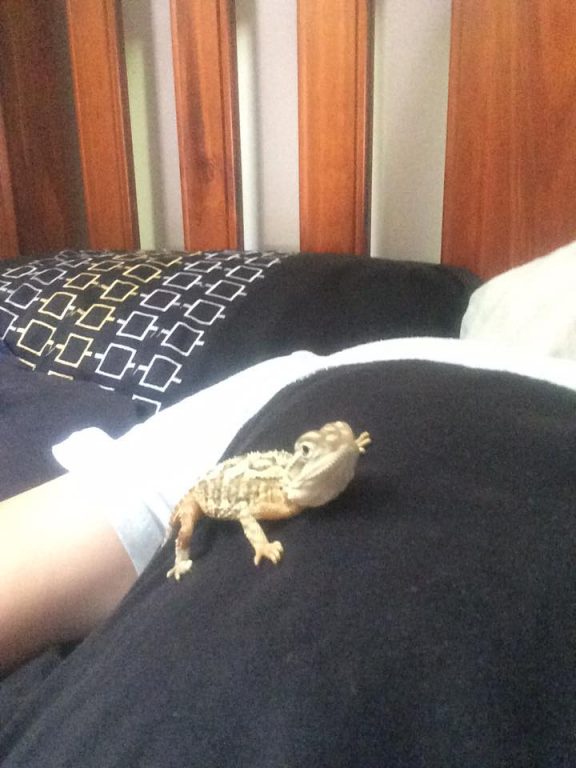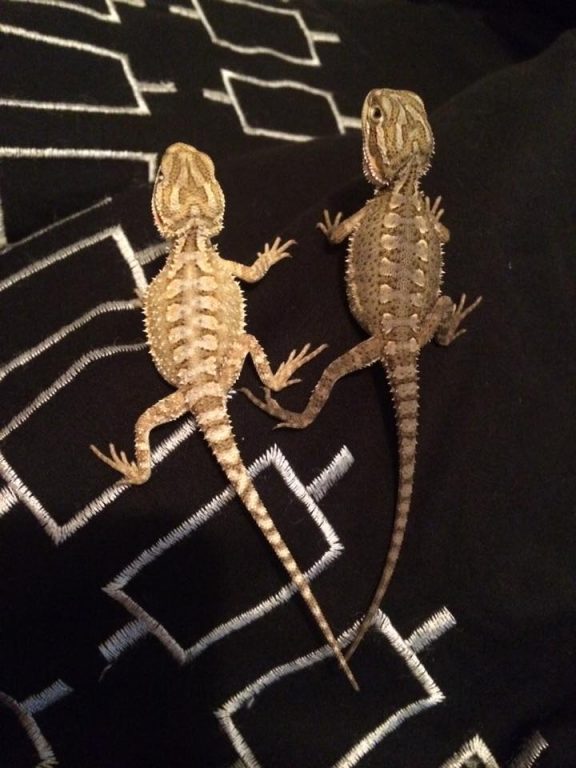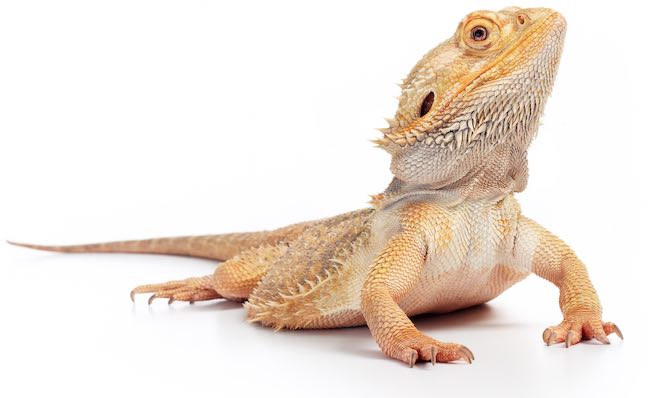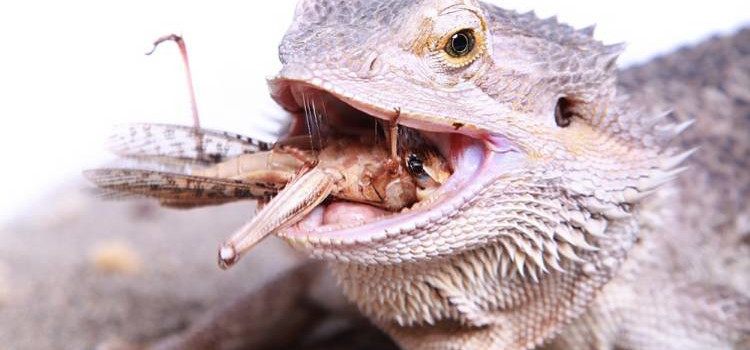The bearded dragon is a common genus of reptile that has the origin from Australia, aka Pogona. The species is in favor of many pets enthusiastic. Bearded dragons are recommended for beginner reptile owners because they don’t demand much of extreme care and habitat as far as reptiles go, but you should be aware that it doesn’t mean they are easy to take care of. Reptiles, in general, have specific care requirements.
It is a pain in the butt as it needs special lighting, food, place and anything in between. So, it’s fair to say that they are high maintenance pets. Next time you hear anyone saying that bearded dragons are easy pets to follow; that means it goes with a comparison to other reptiles in the line that have higher maintenance.
They are said to be a fierce animal as they come from the desert environment; they are used to dry areas of Australia. Therefore, bearded dragon natural habitat can be sunny and fewer water sources. In today article, we are going to learn about how to create a bearded dragon habitat that is ideal in term of living condition, as well as recommendations for making the best bearded dragon habitat ideas possible.
First Time Getting to Know Your Pogona
“Bearded dragon” is a common name for Pogona in the Agamidae family. This species lives in a wide range of arid to semiarid regions of Australia. These Agamas have gained interest from many pets avid around the world. At the mature stage, they can reach 60 cm in length.
In the wild, they rely on the flattening body against the ground to hide and hold the initiative. When they catch a threat, they will wide blow their pointed beard with the opening mouth to offend the enemies. Despite the ghastly expression in the appearance, they are a quite friendly creature and can be silly sometimes with a level of cuteness that you will adore.
In the free environment, they run pretty fast to the hideout before any confrontation. As these animals don’t have the tendency to attack unless they face severe dangers, they wouldn’t show any aggression towards harmless objects which makes them a friendly home pet just like a dog or cat. Bearded dragons can live without water and food for a couple of days, but that doesn’t mean you can leave them unfed while you’re on vacation.
They also own appreciated temperament in which you can approach them (with no harassing attitude) and pet them. Though the affection back could not be obvious, in the long-term life together, you’ll soon realize how sweet they are. You should be acknowledged that all animals bite, so do bearded dragons. But it really depends on how they’re raised and the way they grow the relationship with you is also a factor decide their character. With that being said, if you treat them well, you will have the love back.
Pogona are medium size animal as a full-grown adult. Unlike any savannah monitor or a green iguana which will grow to a huge size and bear the capability to take your hand off, a Pogona is great for being a small child. Even if they even bite you, it should not leave any severe damage that is out of tolerance.
Bearded dragons have a fairly long lifespan.
When you look at a small animal, it seems like they are fragile enough to have only a few months to live, but not the Pogona.
In fact, you can expect them to have at ten years to commit around you. This is what you should consider because this lizard will be your pet for ten years; so, would you be able to take care of the reptile or you will end up putting it for adoption? Since bearded dragons are long-term pets, it is necessary to look ahead before bringing of them home.
#1 Bearded Dragon Habitat
The species is found mostly in the arid woodland and deserts in the Central of Australia. In their waking hours, they spend most of the time in the bushes and trees. You may catch one of them basking on rocks. They dig a hole underground for shelter and will burrow there on the hot days.
#2 Physical Characteristics
Bearded dragons are tan and yellow. The “beard” refers to their ability to flare out the throat skin under stress. Their flatted body supports hiding from enemies while the wedged-shape head has rotary eyes. There are spines on their throat, head on the sides and body. Their tails are as long their body’s length.
Hatchlings and juveniles are hard to identify gender, but it will become more distinctive when they grow.
Male lizards typically have larger heads and darker beards.
#3 Bearded Dragon’s Diet
Pogona is an omnivore species. Their primary sources of food come from insects, mammals, and smaller lizards. They also eat flowers, fruits, and plants in the surrounding. In nature, a bearded dragon balances their diet of meat and vegetable. At hatchling age, they eat mostly small insects.
More vegetables will be added as the lizard grow. A young dragon from 2 to 4 months will consume roughly 80% insects and 20% greens. They eat 2 to 3 times a day. If a bearded dragon is raised in a cage with a mate, they may toe off each other or nip the tails.
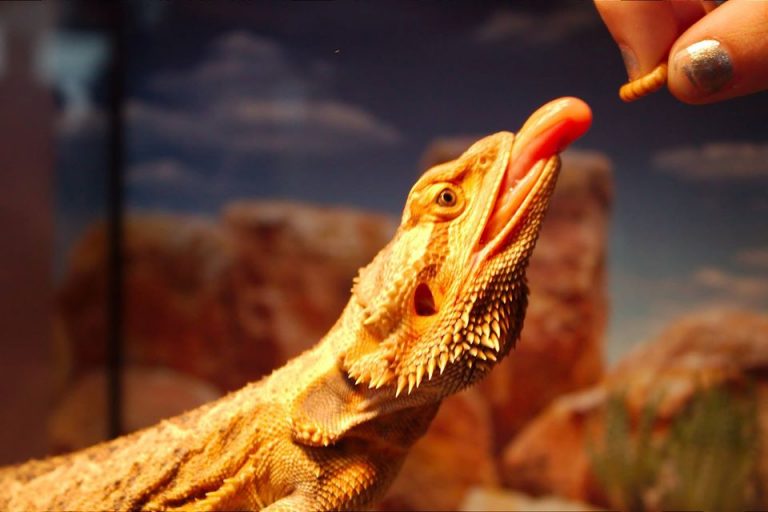
#1 Meat
Bearded dragons take mice and insects like crickets, worms, and cockroaches to be in their protein meals.
#2 Vegetation
Plants and fruits take 20% in a bearded dragon’s diet. Things they can eat include broccoli, okra, carrots, sweet potatoes and common vegetables people eat. Fruits like kiwi, apples, melon or papaya are among the favorite of the lizard. The feed should be torn into pieces and mixed. That would encourage your lizard to eat everything without being picky.
#4 Handling a Bearded Dragon
Since the Pogona reptiles are docile creatures, they tend to enjoy the human company. When picking up a bearded dragon, you need to place your hand under its abdomen then scoop it up. Let the dragon rest on your palm and arm. You can gently pet it with the other hand.
#5 Body Language and Behavior
To build a binding relationship with your bearded dragon, it is their language and habits you need to learn. The puffed-out beard is a sign of hostile attitude towards anything approaching. You should leave your pet alone this time. This behavior applies to both male and female dragon. The lizard also gapes to add more irritated mood that you should definitely stay away. Additionally, they bob their heads to show dominance when housing with another mate.
They may hold up one front leg and slowly wave it to show submission.
#6 Reproduction
The reptile breeds when they reach the sexual maturity between 8 and 18 months. Bearded dragons lay eggs. About 20 eggs once in a clutch. It takes 55 to 75 days to hatch. The lizard also lay eggs when unmated.
Creating a Perfect Habitat For a Bearded Dragon
It is vital to get familiar with your lizard’s personal habit and natural behavior to build a proper home. Once you broke down the matters, you can start off creating a warm and hospitable habitat for your pet today. For a lizard to live long in captivity, the essential things to maintain are lighting and temperature.
You will want to make sure your bearded dragon enclosure is sufficed with UVA and UVB supported by heating, temp gauges, and monitor. All in all, the habitat should mimic the outside environment where lizards are born to live in as similar as possible.
#1 Bearded Dragon Tank Setup
A bearded dragon tank for an adult lizard should be large enough to intimidate the desert. We suggest keeping it in a 55 to a 60-gallon aquarium will make a comfortable home. A cage that is easy to facilitate can be made of wood sealed with polyurethane or another type of waterproofing agent.
If you happen to have a wire cage I the bearded dragon enclosure DIY, make sure you coat the wires with plastic to prevent the possibility of injury. You can leave a caulk joint to supporting cleansing and disinfection. And don’t forget to let the air in and out prior to putting your pet under suffocation.
When putting substrate in the bottom of your beardie’s cage, you can adjust it to fit the aesthetical eyes. Make it cleanable by using the absorbent substrate. You should select the digestible substrate in case your pet swallows. It can be flat newspapers, carpets, or wrapping paper. Do NOT use crushed corn cob, cedar shavings, wood shavings, gravel, cat litter, or potting soil that contains fertilizer, pesticides, vermiculite, or any wetting agent.
#2 Lighting Setup
The first and foremost thing to concern after having the enclosure is the lighting system. Bearded dragons regulate their body temperature relying on the heat from sunlight in nature. The cold-blooded animal can also utilize hot air emitted from other light sources.
In the wild, the beardies receive efficient UV from the desert’s sun. So, you will need to supply this ultraviolet ray from an artificial source. In this case, light bulbs provide with an appropriate choice from the fluorescent lamps and mercury vapor bulbs. These outputs should give enough UVA and UVB in an indoor bearded dragon cage.
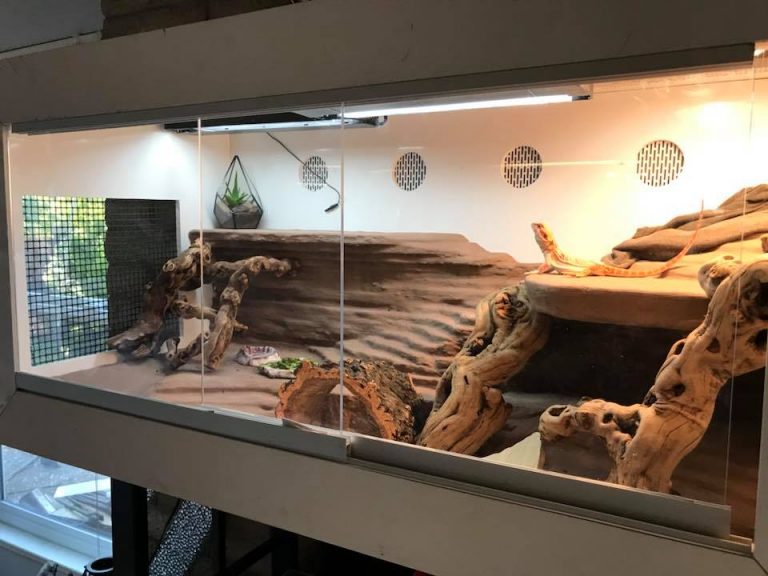
You should now have a map of where to affix the light bulbs.
Mounting them in the right places will ensure even contribution of heat through the tank. Don’t leave the wire in any contact with your reptile. It is best to hang them on top. Reflective elements in the glass cage will be a plus to direct light and heat down.
Wire cages, on the other hand, have the advantage of natural light and temperature; but you will need to set up an open fixture to have all the bulbs heat around the cage.
#1 Fluorescent lights
To install a light system of UVA and UVB rays, you will need a fixture of fluorescent bulbs. Bearded dragons are typically in need of an 8 to 10 percent output of UVB rays. You can rely on that information to select the right specs written on the bulb package. Place these bulbs eight inches from each other on a non-plastic surface. Also, glass or plexiglass could block the rays from penetrating.
Metal mesh material carries the same defect. A good suggestion for a small place is to have dual-fixture that has sockets for incandescent or halogen bulbs. A ballast is needed for the full spectrum bulbs, or you can make use of compact products to save spaces.
With the fluorescent fixture, you should have reflector of aluminum foil to increase the number of UV rays for your bearded dragon.
#2 Compact fluorescent
The incandescent fixtures can accommodate these bulbs for the same function. They are said to make use of less energy and be lasting longer. A warning is that you should be careful with too high UV for your reptile from the bulbs.
#3 Mercury vapor lights
These versatile bulbs can emit both UVA and UVB and heat the enclosure. These bearded dragon heat lamps have more significant longevity than fluorescent light bulbs and heat bulbs. Obviously, they have a higher cost for more durability. But they’re worth every dime. Mercury vapor bulbs are among the favorite light systems used for bearded dragon habitat.
However, the community has reported that they can be dangerous for the reptiles due to the intensity of UV rays generated. If you decide to go with this type of light bulbs, equip the enclosure with shades between your pet and the bulb for safety.
Don’t install this system if you intend to have a small cage.
#3 Warmth Distribution
Bearded dragons are cold-blooded animals. They receive heat from the outside environment to regulate their body’s temperature. If you leave your dragon cold, he won’t be able to digest food and expose himself to illness. You can set up the enclosure to have around 80 to 88oF during the day and 70oF at night.
#1 There should be two sources of heat provided in the habitat.
Primary source
It comes from the light fixtures of heat bulbs. Incandescent lights should be turned off at night whereas lights for nocturnal reptiles or heating pads will take the shift.
Secondary source
The best gradient should cover 20 to 30% of the tank’s surface. These “basking lights” will take care of warming an area when the temperature drops; so, make sure you set them from 90 to 100oF for adult dragons and lower wattage for the hatchlings.
#2 Heat lights
You can skip these bulbs if you make up your mind for the mercury vapor. But if your beardy needs more of warmth, additional heat bulbs are helpful. Baby lizards require 90 to 110oF, while the grown ones demand from 80 to 93oF. There will be separated spots where it’s cooler here and more concentration of heat there. The purpose is to give your lizard a place to regulate when their bodies get too hot or too cold.
As temperature drops at night, a hotter zone will comfort your pet better. Back to the fluorescent fixture, your bearded dragon definitely needs a supplemental heat source. While bearded dragon rocks with heat can cause thermal burns, heat bulbs appear to be safer. They are also a more effective alternative for tank heater for it can distribute temperature more accurately in the enclosure.
#3 Ceramic heat bulbs
This type of bulb provides no light but heat. The bulbs are available in different wattages as same as regular incandescent light bulbs. You will choose the wattage up on the beard dragon tank size. Since it is a variation of heat bulbs, you don’t need two type of them in one place. The highlight of ceramic light bulbs is they have an admirable lifespan, and that makes them not on the budget size. Get a full-spectrum fluorescent light system and place the bulbs on the unmelt surface.
#4 Incandescent heat lights
These all-in-one bulbs can provide not only heat but demanding UV rays as well as light. The incandescent fixture varies in wattage for various tank sizes. They come with removable bulbs with sockets. The sockets are versatile for any type of heat bulbs, even halogen bulbs. They also come in different shapes serving distinctive purposes. Basking lights are designed to direct heat into the certain zone below it leaving shades on the sides.
#5 Halogen heat lights
These light bulbs can emit more light, UVA rays and heat than the incandescent lights of the same size. They cost some extra dollars and last longer than the cheaper options. They are power-saving light bulbs thus is a good investment for a long-term setting. You can use them in coordinate with the incandescent and also fluorescent fixture if you already own one. In the situation where you want a complete halogen fixture, make sure you choose the right wattage so as not to contribute excessive light and heat to the enclosure.
#6 Temp gauges
This tool aids in measuring heat inside of the cage to ensure everything is alright. As your beard dragon tank has one cool and one hot zone, you will need two thermometers. There should be more temperature gauges depends on how large the enclosure is.
#7 What to note down
The ideal habitat has an appropriate combination of visible lights from the fluorescent or incandescent and ultraviolet light source.
Keep the balance between artificial light and the natural light source for your beardie’s good health. Let your lizard enjoy a sunny day under 70oF in a locked wire cage. Provide the cage with some shades and a hiding place.
**NEVER use glass enclosures when accessing to sunlight as light can’t penetrate through, and the material traps heat inside which may cause deadly high temperatures.
The UVB light sources should be replaced every six months.
#4 Landscape and Furniture
An assortment of branches for your bearded dragon to climb and bask is enjoyable. Pick the branches in various size and make they are free of sap or pitch. You can make climbing posts with indoor carpets. Place some flat-bottomed rocks to make the habitat look more like an original mini version of the wild. They also help wear down toenails.
There should be a hideout in the bearded dragon habitat décor. Make use of empty cardboard boxes or flower pots and make it snug into the tank at a high position. If you don’t see your dragon uses the hiding place, move it to a different spot or replace a new hideout. A good-looking landscape should not miss the green. To make the enclosure more like home, add some plants to make it lively.
You can choose among the dracaena, hibiscus or ficus benjaminia for non-toxic plants. Before inhibiting the plants into the tank, you can use water spray to wash out the chemical contamination presents in the plant. The good idea is to have the plants grown around your house before putting them to the cage. Green parts benefit in giving an aesthetic taste to the habitat as well as providing humidity and shades for your bearded dragons.
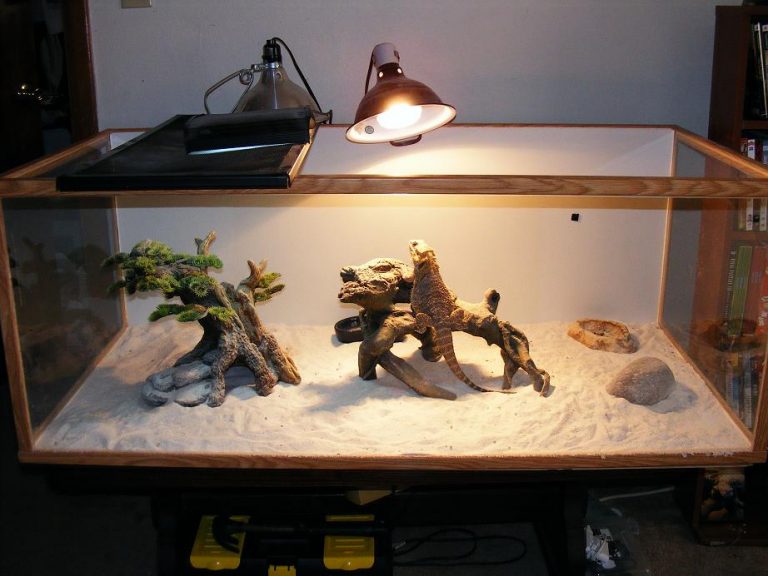
#5 Water and Moisture
Bearded dragons take juice from food to make their source of water. They can drink fresh water too but in rare chances. Though, there should be a shallow water supply available in their cage.
Humidity is a requirement for shedding.
Cold weather may freeze the skin from segregation. High temperature can burn the new thin skin layer. The low moisture during the winter months will mist some tubs of water. Since water stimulates elimination, your dragon can urinate or defecate in the water. You will need to clean these tubs to keep the level of hygiene.
#6 Sanitation
You should have a routine to clean water and food bowls using household bleach or any formulated sanitation solution and rinse the units thoroughly. Let the eating items dry before returning them to the cage because you may allow Salmonella bacteria to harbor your bearded dragon. Also, sanitize your hands before and after handling your lizard. We recommend using rubber gloves when you pick your pet up.
Checklist for Bearded Dragon Décor
#1 Shelter
A full-grown bearded dragon needs a large cage; even larger enclosure if you house more than one lizard. Bearded dragons have territorial nature. They may consider their mates appetizers then not sufficed with food. Make sure you have a large enough cage for them to have enough private zone.
An at least 4 feet long cage should go to your consideration to avoid extra expense for multiple habitats. A terrarium of 55 to 70 gallons will meet the criteria to raise this medium size lizard thorough its life. Invest in a stable stand to situate the terrarium. Put it out of reach of other pets.
#2 Ventilated Top, Privacy, Substrate
Stagnant heat is lethal to bearded dragons. Allow for ventilation using a cover of airing top. We suggest the Zilla Fresh Air Screen Cover for fresh air.
Create a hideout of a cardboard box or flower pots to give the lizard a secluded retreat.
Use brown paper, flat newspaper or indoor carpet to provide a comfortable yet pleasing-eye base.
#3 Heat
Install a fixture of fluorescent or incandescent combining with heat bulbs to create a heat zone and cooling zone. Set up a primary light source to illuminate the whole cage while the secondary system is the supplemental heat source covers 25 to 30% of the area. Use recessed reflector or heat lamp on each end of the terrarium top.
There should be one basking spot for your lizard to make it stay away from the heat source.
#4 Light
It is a good idea to combine both fluorescent and incandescent fixture in one place to make you will provide enough UVA and UVB. There is the Black Heat Lamp that simulates moon glows to entertain your pet. It should extend enjoyment for your lizard. Screw in some thermal meters to take control over the temperature.
Build a dragon terrarium and its environment step-by-step. In this tutorial, we will go through the steps of creating an ideal bearded dragon tank fully equipped for an adult lizard (or two). Before putting your hands on the project, let’s see what ingredients you need for the enclosure.
#5 Tank
Glass aquarium: This is the most preferred tank in the community for its good-looking. It is an inexpensive option with a few drawbacks in term of insulation. Glass material traps heat inside, and it will become blurry with time making a poor vision.
Melamine Cage: You can DIY this type of tank with material bought from a local hardware store. Melamine board is easy to find and works pretty well in reflecting light that enlightens your bearded dragon. However, melamine is extremely expensive and cumbersome to carry when it comes to moving.
ABS and PVC Cage: These two types of plastic look similar to each other. They share the same characteristics of being transparent, sturdy and lightweight. The downside is ABS plastic produces less odor than the PVC. They are both not on the budget size.
Vision cage: This type of cage is made for raising reptiles professionally. It is made of a molded piece of plastic that can resist chemicals
They come with built-in heat lamp shrouds and can stack on top of each other. The well-designed cage has a high price tag but worth every penny.
#6 Tank Covers, Lids and Size
Don’t pick the solid tank lids that restrict air flow from the inside. Plastic and glass lids generate excessive humidity a bearded dragon need. You will need to keep the moisture low while preventing the dragon to escape. The best way to do it is to use a screen lid cover which can withstand the heat as well as bear the weight of your light fixture.
Here is a guideline of a bearded dragon tank size regarding the age of a bearded dragon.
- Babies: 20 gallons. Small space allows them to hunt with ease.
- Juveniles (10 – 16 inches): 40 gallons.
- Half adults (16 – 20 inches): 50 to 75 gallons
- Full-grown (above 20 inches): 75 gallons for a single one. 120 gallons for two mates.
#1 Substrate for Bedding
You would want to go for a desert substrate that can stay dry in the top layer and moist in the middle and bottom layer for optimum root growth. It should as well maintain the low humidity level required for the tiny ecosystem. You can make use of old newspaper in clods, carpets, paper towels or butcher paper.
#2 Pour the Substrate
First thing in the section is to dump the substrate the tank. For a large tank, you’re going to need more than one bag. Distribute the substrate evenly to make a natural ground ideal for any green development for about minimal 3 inches in depth. The next thing is you want to water the soil layer you just spread to give it some moisture. Don’t put a lot of water this time. Let the liquid fall from the top surface to the pocket.
#3 Mosses Dried Palm Leaves (Optional)
If you live in a dry area with extremely low humidity, you will need to add some spag moss to help the soil stay wet for longer. Before affixing the moss, add some water to the bag and shake to mix everything inside. Dub the moss into the tank; you can actually mix it to the substrate to aid humidity. The palm leaves are also optional if you want to provide an excellent food source for any springtails and isopods.
These biodegradable products slowly break down and benefit your soil. They are nutritious snacks to bugs that are meals to your lizards. So, investing in these pieces of stuff is a long-term business.
**Bioshot is for supplemental and beneficial microorganisms and nutrients for bioactive vivaria. It has microbial fungi that promote aerobic bacterial and provide macro-nutrients to the plants as far as it’s a bioproduct to the composition processes. You can use this product to active the soil health in the entire enclosure.
#7 Distribute Springtails
Disperse a cup of springtails, isopods, mealworms, earthworm and wax worms along the cool side creating an abundant food source ready for your bearded dragon.
They are involved in creating the necessary air pockets as well as breath to provide fun snacks to your dragon as they decide the bioactive vivarium.
#8 Leaf Layer
After you’re done with establishing the bugs. The next step is adding the top floor of the biodegradable layer of leaves. Oak, maple or magnolia is the top choice in our perspective as the microfauna finds it easy to break down providing organic nutrition into the soil, thus keeping the vivarium healthy.
Spread the leaves around so the bugs will have a lot of surface areas to dwell. These leaves are commonly going with the bearded dragon starter kit to build up the first habitat. If you get the bags of two leaf types, use them all for the tank.
#9 Light and Heat Fixture
By all mean of providing light, it should mimic the sunlight which delivers UVA, UVB, and heat. Generally, all lights provide UVA, but only special light rays offer both UVA and UVB. When setting up, you want the UVB supplier and the heat lights to be one side of the cage. Put a thermometer under the bulbs so you can watch and control the temperature.
If the temperature rises too high, you can lift the heat light a bit higher. It is even better if you can get the all-in-one artificial sun in a light bulb providing both heat and UVB. A timer would be useful, so you don’t have to worry about switching the light on and off. With the light setup of fluorescent and incandescent, keep in mind that you have to replace the bulbs every six months.
Note of temperature:
95oF to 110oF is the ideal range for a bearded dragon tank. The cool zone can go for 85oF. At night, keep the temperature at 70oF to 75oF. Or you can use an under tank heater.
#10 Decorating
The best part about the bearded dragon is that they are intelligent animals. They enjoy digging, burrowing and eating. Based on their natural habitat, you can imitate the scenery to create a mini desert.
#11 The green part
So, if you plant healthy edibles in their enclosure, for example, mint, oregano, hibiscus, Opuntia cacti, echeveria succulents, rosemary, ficus and so on; these plants provide a rich natural environment as they would in the wild. The plants also give a pleasant smell to your tank as well as meet the aesthetical sense. If you have a wood branch already in hand, pick a nice spot and place it. It is likely that the vine will become a basking area for your lizard, position it at where you are going to set up the heat bulbs.
You can pick some of the branches that grow in your garden, the ones that can evolve from a mere cut and are easy to take care of. Make sure that the plant is harmless in case your bearded dragon ingest it. Cactus is an edible plant with high calcium that is one of the preferred dishes of the bearded dragon. Plant more in the habitat to make it look green but not like a jungle. Cover the root bases after planting. Also, put more wood establishes to your lizard to climb. Distribute the logs across the tank both in the cool and hot zone. Last but not least, use clean shallow bowls to contain food and water.
#12 Hideout
Your bearded dragon would feel more secure if it has a place to retreat. This spot should be positioned under the basking area to have enough warmth. There you have everything set up in one place and is ready to be a perfect home for your beardie.
To wrap it up
Establishing a bearded dragon habitat all goes around simulating its natural wild environment as much as possible. The fundamental task doesn’t require much knowledge in term of creating an ideal place. You just pay attention to the three essential keys covering light, heat, and food source. It is those factors determine your lizard’s healthy life and happiness.
Sufficing temperature and meals will ensure your bearded dragon a flawless home. While bugs and insects play the entertaining roles in the tank for the dragon to play with, outside food guarantee nutrition. This is important when you have two lizards in a tank as they wouldn’t dominate each other for dinner. The other concerns between are related to making the cage look more feral with earth, dried leaves, and trees.
The more the habitat resembles the wild, the happier your lizard will be. You don’t have to put everything once in the first time; as for the decorating things can be added later, go for the critical business. Bearded dragons are admirable creatures for keeping a majestic yet humble look. They make great pets with exceptional, unique affection to their owners.
As lizard enthusiastic, we know that you can’t wait to build the prettiest habitat for your bearded dragon. We know your lizard deserve the love; so, we hope we have broken down the steps instructively enough to make everything easy for you. Otherwise, you can always write to us to inquire more advice to create the best tank for your bearded dragon. We look forward to hearing from you and don’t forget to show us you finish terrarium.
